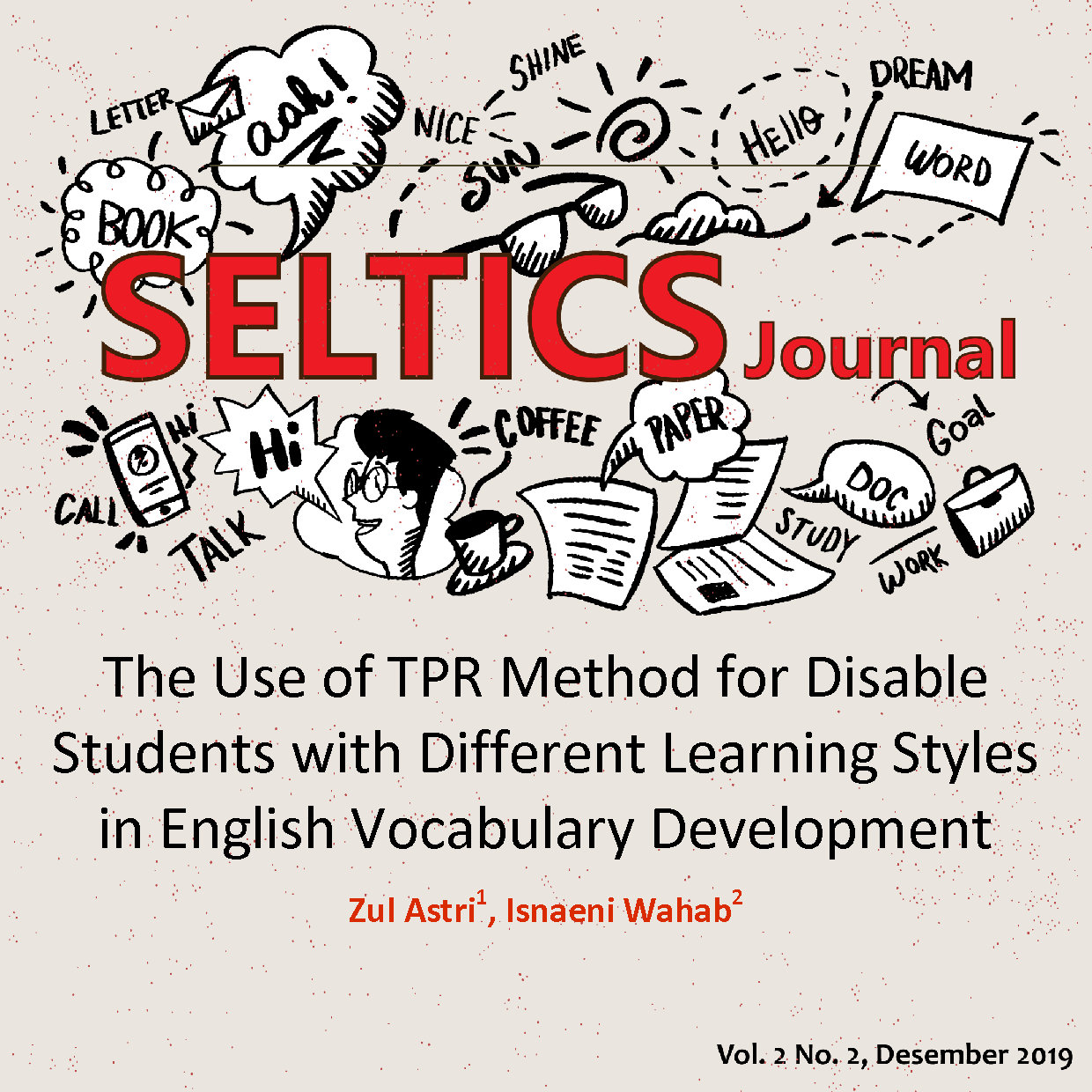THE USE OF TPR METHOD FOR DISABLE STUDENTS WITH DIFFERENT LEARNING STYLES IN ENGLISH VOCABULARY DEVELOPMENT
Keywords:
TPR, Method, Learning, Style, Disable, StudentsAbstract
Teaching English as a foreign language to mentally retarded persons is much more complicated than normal EFL students, and it requires specific techniques and methods. The aims of the research are to find out the profile of disabled students’ learning style and to elaborate on how well Total Physical response meets the needs of disabled students with different learning styles. This research applied pre-experimental design which used to see the result of applying the TPR Method for disable students with different learning styles in vocabulary development and the data were obtained from the questionnaire, interview, and classroom observation. The research result shows that there are 3 types of learning styles in the classroom, namely visual learning, auditory and kinesthetic learning style. The data revealed that the average pre-test results of students before being given teaching material using the TPR method is 5% while the results obtained by students after giving teaching material using the TPR method is 77%. 100% of visual learners have improved the result of the post-test after being given the material. 100% of auditory learners also have an increase in the result of the post-test after the provision of teaching materials using the TPR method. However, only 50 percent of 100 percent kinesthetic learners experience an increase after the provision of teaching materials using the TPR method. There are many factors that can influence the result of the student’s test. It can be in the form of internal factors that can stimulate the concentration and the motivation of students in learning English
References
Alhaysony, Maha. 2012. Vocabulary Discovery Strategy Used by Saudi EFL students in an Intensive English Language Learning Context. International Journal of Linguistics February 2012 Vol.4, No.2: ISSN 1948-5425 .Retrieved from http://dx.doi.org/10.5296/ijl.v4i2.1724 accessed on February 24th 2014
Asher, J. (1968). Total physical response method for second language learning. San Jose: San Jose State College.
Barsch, Jeffrey. 1980. Barsch Learning Style Inventory. Retrieved from http://www.windward.hawaii.edu/trio/forms/participant_inventories.pdf accessed on 29th January 2014.
Chamont, Anna. 2005. Language Learning Strategy Instruction special abilities: Current Issues and Research. Annual Review of Applied Linguistics, 25, 112-130
Gilakjani, Abbas. 2012. Visual, Auditory, Kinesthetic Learning Styles and Their Impacts on English Language Teaching. Journal of studies inEducation. ISSN 2162-6952 2012, Vol.2, No.1.
Larsen, Diane and Freeman. 2000. Technique and Principles in Language Teaching Second Edition. New York: Oxford University Press
Larsen - Freeman, D.1986. Techniques and principles in language teaching. NewYork: Oxford University Press
Mirjalili et al. 2012. The Effect of Semantic and Thematic Clustering of Words on Iranians Vocabulary Learning. American International Journal of Contemporary Research. February 2012 Vol. 2 No.2
Nasir, AM. 2016. Statistik Pendidikan. Yogyakarta: Media Akademi.
Richards, Jack & Rodgers. 1986. Approaches and Methods in Language Teaching. Cambridge: Cambridge University Press
Richard & Rodgers, T. 2001. Approaches and methods in language teaching (1st ed). Cambridge: Cambridge University Press
Sirajuddin, Andi. 2010. Improving speaking ability by using Total Physical Response Strategy at SMA Negeri 1 Samarinda. Unpublished Thesis. Hasanuddin University
Sugiyono. 2013. Metode Penelitian Kombinasi (Mixed Methods). Bandung: Alfabeta
Ummah, S.S. 2017. The Implementation of TPR (Total Physical Response) Method in Teaching English for Early Childhood. Advances in Social Sciences, Education and Humanities Research (ASSEHR), Vol.58, p. 421-428









